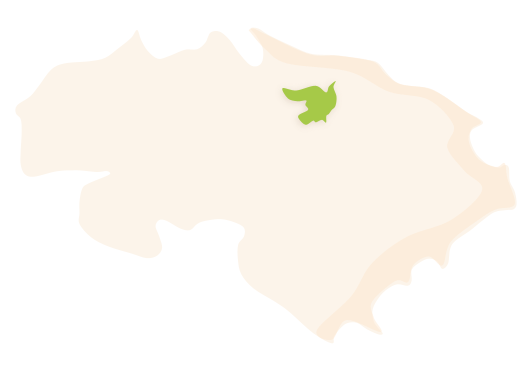Ondara is a municipality located in the northeastern part of the region, in the basin of the lower course of the River Girona, sitting at 36 metres above sea level and with a territorial extension of 10.4 km², mostly occupied by a large arable plain with the exception of the Serra de Segària mountain range to the west of the municipality. The municipal area is made up of Ondara and a secondary nucleus, Pamis. There are a total of 7,080 inhabitants, known as Ondarencs and Ondarenques.
 Ondara's municipal district. Surface area: 10.4 km². Population: 7,080 (INE data 2021).
Ondara's municipal district. Surface area: 10.4 km². Population: 7,080 (INE data 2021).HISTORY
The first vestiges of human settlements close to Ondara are located in the Colom and Corb caves (Middle Paleolithic), as well as in the cave known as Cova Fosca (Eneolithic).
They are of special interest due to their proximity to the current urban centre and due to links to the arrival of Roman colonisers in Dénia, the discovery of several villas, necropolises and Roman ceramics in parts of the Font, Pujades and Vinyals areas, where numerous vestiges have been recovered, as well as several honorary and funerary inscriptions in the old part of the town.
However, the current nucleus did not originate until the Muslim era, when Ondara had great relevance. Arab domination in Ondara led to the expansion of irrigation systems that still exist today, as well as agricultural development and significant population growth. The exploitation of the River Girona's water resources make up a large part of the municipality's heritage, with noteworthy examples of hydraulic mills, ponds, ditches and weirs.
With the arrival of the Christians to these lands and the conquest campaign carried out by Jaume I, Ondara became together with Benissa and Murla the only three mixed populations in the entire La Marina Alta region, which had 80% Moorish population in the 15th century. It is also worth noting that a castle-palace existed in the town from the 14th or 15th century onwards, typical of the Valencian Civil Gothic style with four towers at the ends, similar to the Castle of Forna, and of which only a few remains can be seen today amongst the dividing walls of the adjacent houses.
In 1609, with the expulsion of the Moorish population, Ondara suffered a great demographic loss with only 13 old Christian inhabitants remaining. On August 8th, 1611, the municipal charter was signed, with which a mixed repopulation began with the permanence of the Christian inhabitants and the addition of people from Dénia, Xàbia, Teulada, Oliva and also islanders from Manacor such as the Cabrera family, or from Muro like the Pons family. With this, the Order of Saint Francesc de Paula was established, under the protection of the Marquis of Guadalest, lord of the town.
During the War of Succession, Ondara became one of the supporters and collaborators of the side of Archduke Charles and the Maulets (Valencian partisans who were supporters of the House of Austria and enemies of the botiflers, supporters of the House of Bourbon). This is why the Bourbon army looted and burned the town as punishment. After overcoming this crisis, Ondara recovered economically thanks to the silk trade and the construction of the dam on the River Alberca, which was used to expand the irrigated lands. This, along with the boom in grape cultivation for raisin production, helped to build many of the imposing buildings of the historic centre and others as emblematic as Plaça de Bous in 1901.
FESTIVITIES
- The festivities of Saint Jaume are celebrated between the last two weekends of July.
- The patronal festivities of La Mare de Déu de La Soledat are held during the second weekend of July.
- The festivities of Santíssim Crist are celebrated during the third weekend of June in the neighbourhood called Barri del Crist.
- The popular festivities of Pamis are held during the weekend following the Saint Jaume celebrations.
GASTRONOMY
- Rice with fava beans.
- Fried “coques”.
- Sausages.
- Paella.